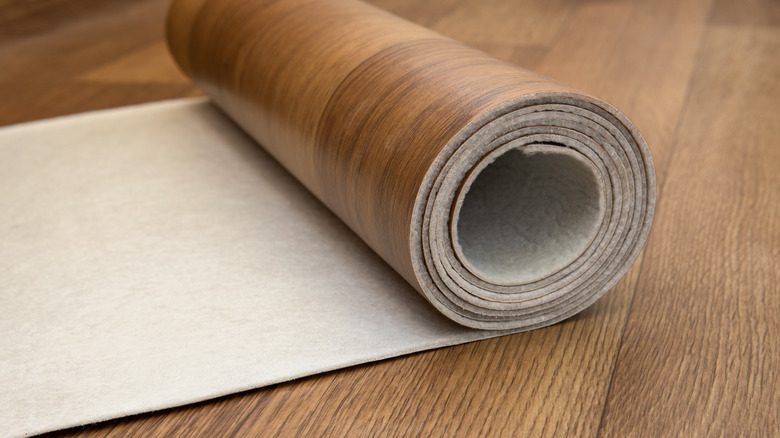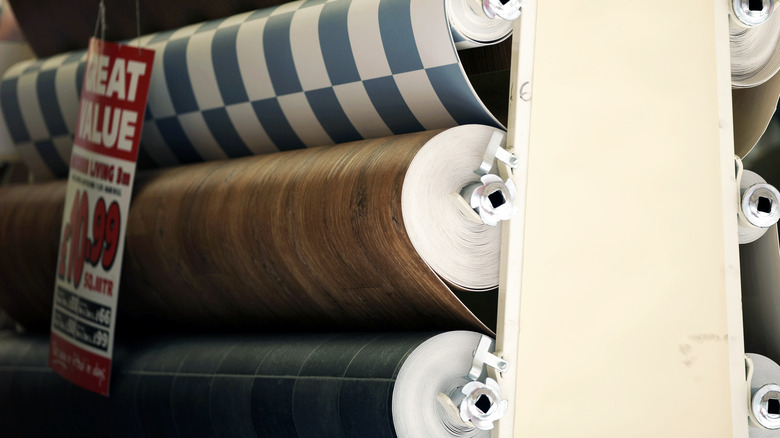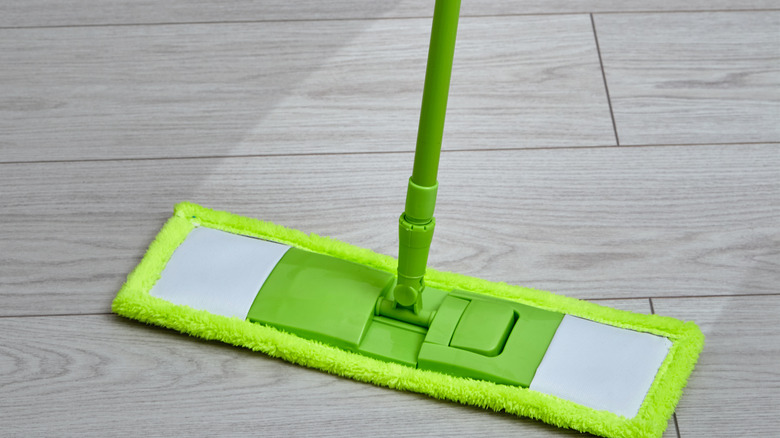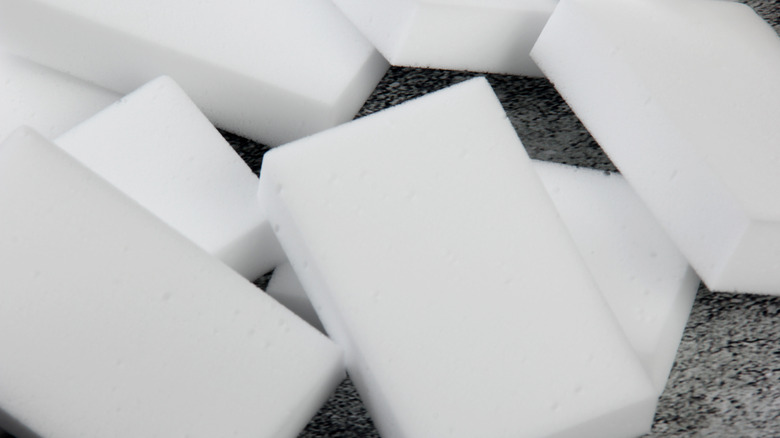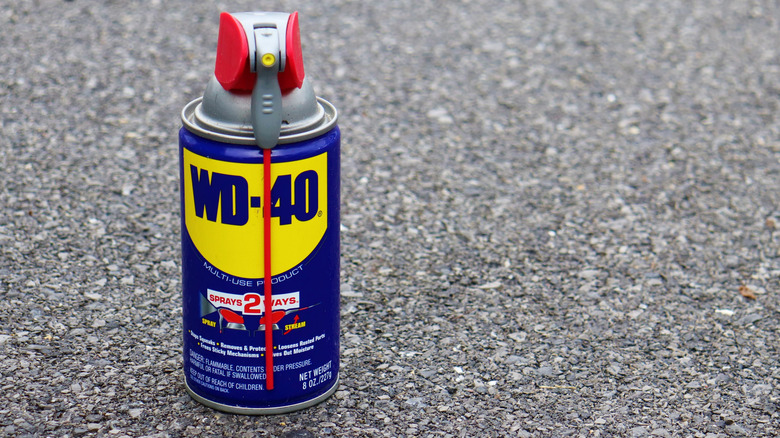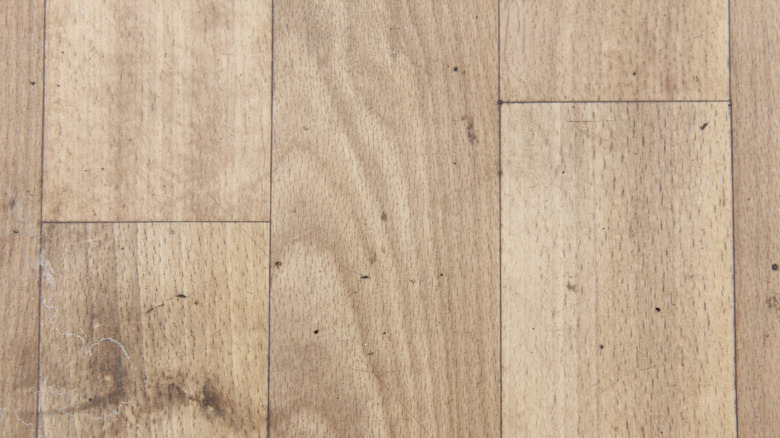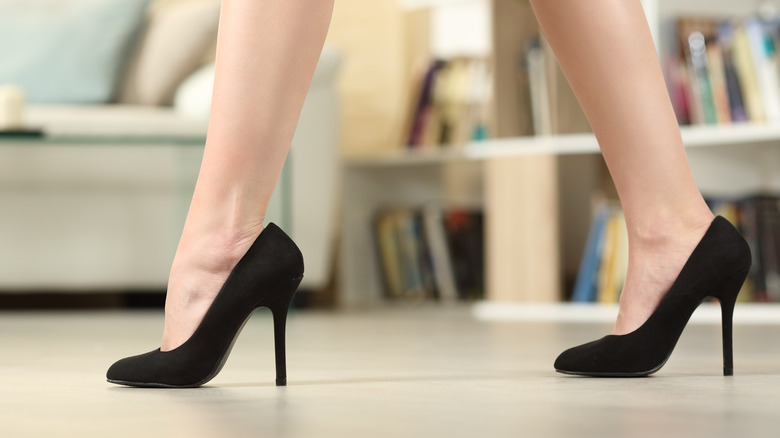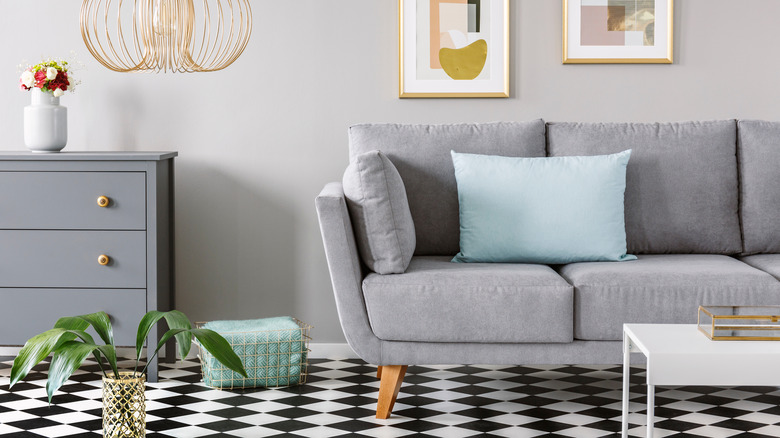8 Easiest Ways To Clean Linoleum Floors
While linoleum floor first came out in the mid-1800s, the material still remains a popular choice more than 100 years later because of its durability, eco-friendliness, and low maintenance. Linoleum can last 40 plus years if cared for correctly, according to the DIY Network, which explains that the pigments of the pattern actually go throughout the flooring — preventing fading and helping hide and scratches.
The Spruce pointed out that since natural substances like linseed oil, limestone particles, ground cork, and wood dust fill linoleum flooring, you need to keep away from harsh cleansers and be mindful about hurting its exterior. Still, cleaning the floor isn't difficult. Depending on how often you use the room, a weekly sweep-up and mop should remove dirt and grime. After sweeping and mopping the floor, you do need to absorb any extra moisture with a towel or cloth. Standing water can damage linoleum, warping and discoloring it, according to Home Steady. The seams of the floor can even loosen and actually ruin the floor. For that reason, linoleum is not ideal for bathrooms, with their potential tub and toilet overflows.
Here are the eight best ways to clean your linoleum floors.
1. Do a general cleaning once a week
There are two no-nos when cleaning your linoleum floor: Avoid ammonia-based cleaners and watch the water, according to Bob Vila, who recommends doing a quick dust-mop each day to get rid of any dirt. With linoleum floors, a good cleaning should start with removing the surface dirt with a broom or a vacuum, using its hard floor attachment. Mopping should include some sort of neutral-pH cleanser especially for linoleum or an assortment of DIY-type concoctions.
Bob Vila suggested using a slightly wet mop, and cleaning the floor in 4- to 6-foot sections. Once the entire space is scrubbed, it's important to rinse the floor thoroughly. Any suds left behind become sticky, allowing dirt to attach to it quickly again — and you'll lose the housecleaning battle. Similar to wood, linoleum also faces damage with too much moisture, so attack any remaining wetness with towels. If you find any resistant spots, use a soft-bristle brush and a light but persistent touch to remove.
2. Use less abrasive cleansers
Commercial detergents might fill the shelves, but their high acidity can hurt your linoleum floor, actually removing the finish. This is why so many linoleum owners embrace more natural substances to rid their floor of dirt and grime. One option is white or apple cider vinegar, according to The Spruce, who suggested using 1 cup of it in a gallon of water. If you want something a bit more pleasant-smelling, just add a dash of lemon juice and that sharp, clean scent will fill the air. Up the ante and get the area sparkling clean by sprinkling some baking soda on the floor before mopping it with the water/vinegar mixture. It's a killer combo and your stains should scrub gently away.
Other cleaners like dish or liquid castile soaps also work well for cleaning linoleum, said Tips Bulletin. You don't need much of the substance either, maybe a tablespoon or so per gallon of warm water. Mix thoroughly, but try not to make too many suds. Borax is another ingredient that can pack a punch — try 2 tablespoons to 1 gallon of warm water. Otherwise, you'll have trouble removing all the detergent.
3. Use appropriate commercial cleanser
Sometimes you want a little more oomph than DIY cleansers. Maybe you want more of a deodorizer, or a product that is anti-bacterial or mosquito-resistant. Commercial cleansers work well with linoleum, but you need to choose carefully, advised Mom Junction. Since linoleum is made from natural materials, you can damage it with anything too harsh, according to Living Proof Magazine; your floor can lose its shine or worse. The Floor Critics recommended avoiding any alkaline-based methods, especially ones that contained ammonia, for example. This is one of the reasons why you want to keep Fido out of the room, as one accident left unattended too long can really discolor your floor.
So the moral of the story here is to read labels carefully before purchasing any products. It is also a good idea to test out cleansers before using them on a small, out-of-the-way floor space. That way there is no surprises.
4. Try a Magic Eraser
Since Magic Erasers arrived in 2003, they have eased homeowner's cleaning responsibilities, said Family Handyman. The magic here is melamine foam that contains formaldehyde-melamine-sodium bisulfite copolymer ... just add water and a little elbow grease and presto, scuffs and other marks, including spilled tea and coffee remnants, disappear. The mix of hydrogen, carbon, and nitrogen helps obliterate all sorts of grime without hurting the substance you're cleaning. The Magic Eraser is like a fine sandpaper and will help break down the stain.
One con of this special sponge, though, is it becomes nublike quite quickly. Its porous nature makes it break down, so a big job might need more than one. While the sponges are non-toxic, the Magic Eraser is abrasive. So be careful when using them that they don't rub your skin.
While many embrace this method for linoleum floors, it is always a good practice to do a dry run and test a small section of your floor before using, advised Stain Removal 101. You should also reserve the Magic Eraser for small sections because the abrasive can dull the floor's surface. If the floor you are working on is waxed, this product will strip that away and you might need to reapply the protective layer.
5. Avoid allowing stains to set
Linoleum will appreciate your diligence in cleaning up and spills right away. While the material is antibacterial — and resistant to mildew and mold — it is also porous. That means a stain can go all the way through the flooring. The best defense is to clean away anything before it happens. Otherwise, you'll need to buff the mark out with a nylon brush and then polish the area to reinstate its shine.
Some stains can ruin your flooring. Fortunately, you can use some DIY techniques on ugly scuff marks. For instance, baking soda and water can remove black shoe lines and baby oil, or WD-40 can lift other ugly discolorations. Whatever cleanser you use, be sure to rinse it off thoroughly and dry the flooring when you are done (via Bob Vila).
If the stain won't come out, you can also try a bit of peroxide to remedy the situation, especially if its an organic one like blood or urine, said Clean It Supply. Take a peroxide-sodden cloth and apply it to the stain, along with some pressure. Perhaps put a bucket on top of it. The cloth should absorb the discoloration over time. If the rag becomes dry or dirty, put down a new one.
6. Polish linoleum floors
Most linoleum floors benefit from an occasional coat of floor finish to rev up the shine, but too much of a good thing will make the floor look dull and discolored. You never want wax build-up, advised Hunker. One thing that can cause that is using the wrong cleanser, or sometimes it just builds over time. You can remove excess wax, though, with a concoction of one part rubbing alcohol to three parts water. Scrub the floor with a nylon brush and then mop with clean water. You should aerate the room as you work by opening a window or using a fan.
Even floors that require waxing might need a good stripping now and again, according to SF Gate. The site recommends another way to give the floor a deep clean, by using 1 cup of ammonia to ½ gallon of warm water. Leave the solution on for five minutes, before scrubbing it with a nylon brush or scouring pad. This should remove the wax, which you can then mop up with clean water. Dry with a towel and if any loose wax remains, sweep or vacuum the floor. Then you'll need to apply fresh wax. Follow the instructions and then let the floor dry before anyone walks on it.
7. Prevent discoloring and scratches
Part of keeping your linoleum shining and perfect is by paying attention. A floor can discolor and get scrapes quite easily, said Hunker. So close the room to animals with nails and spiky high heels. Sunlight also hurts linoleum, so invest in curtains and shades and keep them closed with the rays are brightest.
Linoleum contains linseed oil, a substance that likes some sunlight, said How to Clean Stuff. Otherwise it will oxidize and alter its tone. So if you use floor mats and rugs on your linoleum floor, you might one day tire of them, lift them up, and see an array of colors you weren't expecting. Fortunately, you may remove this by using baking soda and water. Wet the area and then toss some baking soda on the stains, let it sit for 10 to 15 minutes, and then wipe up the mixture. Sometimes several applications are necessary to remove the mark. Keep in mind that you when you are done, you should ensure that homemade remedy is washed away and then the floor is dried.
8. Deep clean annually
Sometimes weekly maintenance is not enough and you'll need to super clean anything that embeds itself into the linoleum flooring. Depending on how much action the room gets, you should do this once or twice a year. First, you need to gather some materials, including a vacuum, a soft-bristle brush, microfiber mop, bucket of hot water, baking soda, dish soap, and some towels, advised Molly Maid.
You always start by gathering any loose debris off the floor since something like a small pebble can scratch the floor if you drag it with the mop. Gently sweep up or vacuum any bits of waste. Then you'll distribute baking soda along the floor before mopping it with a mixture of 1 gallon hot water, 1 cup of vinegar and just a dash of dish soap. Tackle any hard-to-remove marks with a soft scrub brush. Once the floor is clean, follow up with a mopping using clean water, as you want to ensure that all of the cleanser is gone. Then take your towels and blot up any excess water.
